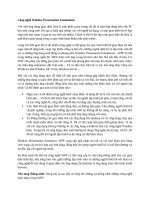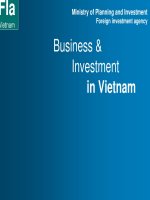princ ch28 presentation
Bạn đang xem bản rút gọn của tài liệu. Xem và tải ngay bản đầy đủ của tài liệu tại đây (952.59 KB, 42 trang )
CHAPTE
R
28
Unemployment
Economics
N. Gregory
PRINCIPLES OF
Mankiw
Premium PowerPoint Slides
by Ron Cronovich
© 2009 South-Western, a part of Cengage Learning, all rights reserved
In this chapter,
look for the answers to these
questions:
How is unemployment measured?
What is the “natural rate of unemployment”?
Why are there always some people unemployed?
How is unemployment affected by unions and
minimum wage laws?
What is the theory of efficiency wages, and how
does it help explain unemployment?
2
Labor Force Statistics
Produced by Bureau of Labor Statistics (BLS),
in the U.S. Dept. of Labor
Based on regular survey of 60,000 households
Based on “adult population” (16 yrs or older)
UNEMPLOYMENT
3
Labor Force Statistics
BLS divides population into 3 groups:
Employed: paid employees, self-employed,
and unpaid workers in a family business
Unemployed: people not working who have
looked for work during previous 4 weeks
Not in the labor force: everyone else
The labor force is the total # of workers, including
the employed and unemployed.
UNEMPLOYMENT
4
Labor Force Statistics
Unemployment rate (“u-rate”):
% of the labor force that is unemployed
u-rate
# of unemployed
= 100 x
labor force
Labor force participation rate:
% of the adult population that is in the labor force
labor force
labor force
= 100 x
participation rate
adult population
UNEMPLOYMENT
5
ACTIVE LEARNING 1
Calculate labor force statistics
Compute the labor force, u-rate, adult population,
and labor force participation rate using this data:
Adult population of the U.S.
by group, June 2008
# of employed
145.9 million
# of unemployed
8.5 million
not in labor force
79.2 million
6
ACTIVE LEARNING 1
Answers
Labor force
= employed + unemployed
= 145.9 + 8.5
= 154.4 million
U-rate
= 100 x (unemployed)/(labor force)
= 100 x 8.5/154.4
= 5.5%
7
ACTIVE LEARNING 1
Answers
Population = labor force + not in labor force
= 154.4 + 79.2
= 233.6
LF partic. rate
= 100 x (labor force)/(population)
= 100 x 154.4/233.6
= 66.1%
8
Labor Market Statistics for Different
Groups
The BLS publishes these statistics for
demographic groups within the population.
These data reveal widely different labor market
experiences for different groups.
UNEMPLOYMENT
9
Labor Market Statistics for Whites &
Blacks,
June 2008
Adults (20 yrs & older)
u-rate
LF part. rate
White, male
4.5%
76.1%
White, female
4.2
60.4
Black, male
9.3
71.5
Black, female
7.4
64.3
UNEMPLOYMENT
10
Labor Market Statistics for Whites &
Blacks,
June 2008
Teens (16-19 yrs)
u-rate
LF part. rate
White
16.6
43.9
Black
29.6
27.9
UNEMPLOYMENT
11
Labor Market Statistics for Other
Groups,
June 2008
All ages
u-rate
LF part. rate
Asian
4.5
67.4
Hispanic
7.7
69.0
UNEMPLOYMENT
12
Labor Market Statistics by Education
Level,
June 2008
Adults (25 yrs & older)
u-rate
LF part. rate
less than h.s.
8.7%
45.9%
h.s. diploma
5.1
62.8
some college or
assoc degree
4.2
71.9
bachelor’s
degree or more
2.3
78.1
UNEMPLOYMENT
13
LF Participation Rates by Sex, 19502007
Men
Women
UNEMPLOYMENT
14
ACTIVE LEARNING 2
Limitations of the u-rate
In each of the following, what happens to the u-rate?
Does the u-rate give an accurate impression of what’s
happening in the labor market?
A. Sue lost her job and begins looking for a new one.
B. Jon, a steelworker who has been out of work since
his mill closed last year, becomes discouraged and
gives up looking for work.
C. Sam, the sole earner in his family of 5, just lost his
$80,000 job as a research scientist. Immediately,
he takes a part-time job at McDonald’s until he can
find another job in his field.
15
ACTIVE LEARNING 2
Answers
A. Sue lost her job and begins looking for a new one.
u-rate rises
A rising u-rate gives the impression that the labor
market is worsening, and it is.
16
ACTIVE LEARNING 2
Answers
B. Jon has been out of work since last year,
becomes discouraged, stops looking for work.
Discouraged workers
would like to work but have given up looking for jobs
classified as “not in the labor force” rather than
“unemployed”
U-rate falls because Jon is no longer counted as
unemployed.
A falling u-rate gives the impression that the labor
market is improving, but it is not.
17
ACTIVE LEARNING 2
Answers
C. Sam lost his $80,000 job, and takes a part-time
job at McDonald’s until he finds a better one.
U-rate unchanged because a person is “employed”
whether they work full or part time.
Things are worse, but the u-rate fails to show it.
18
What Does the U-Rate Really
Measure?
The u-rate is not a perfect indicator of joblessness
or the health of the labor market:
It excludes discouraged workers.
It does not distinguish between full-time and
part-time work, or people working part time
because full-time jobs not available.
Some people misreport their work status in the
BLS survey.
Despite these issues, the u-rate is still a very
useful barometer of the labor market & economy.
UNEMPLOYMENT
19
The Duration of Unemployment
Most spells of unemployment are short:
Typically 1/3 of the unemployed
have been unemployed under 5 weeks,
2/3 have been unemployed under 14 weeks.
Only 20% have been unemployed over 6 months.
Yet, most observed unemployment is long term.
The small group of long-term unemployed persons
has fairly little turnover, so it accounts for most of
the unemployment observed over time.
Knowing these facts helps policymakers design
better policies to help the unemployed.
UNEMPLOYMENT
20
Cyclical Unemployment vs. the
Natural Rate
There’s always some unemployment, though the urate fluctuates from year to year.
Natural rate of unemployment
the normal rate of unemployment around which
the actual unemployment rate fluctuates
Cyclical unemployment
the deviation of unemployment from its
natural rate
associated with business cycles,
which we’ll study in later chapters
UNEMPLOYMENT
21
U.S. Unemployment, 1960-2007
percentage of labor force
12
10
Unemployment rate
8
6
4
Natural rate of
unemployment
2
0
1960 1965 1970 1975 1980 1985 1990 1995 2000 2005
Explaining the Natural Rate: An
Overview
Even when the economy is doing well, there is
always some unemployment, including:
Frictional unemployment
occurs when workers spend time searching for the
jobs that best suit their skills and tastes
short-term for most workers
Structural unemployment
occurs when there are fewer jobs than workers
usually longer-term
UNEMPLOYMENT
23
Job Search
Workers have different tastes & skills, and
jobs have different requirements.
Job search is the process of matching workers
with appropriate jobs.
Sectoral shifts are changes in the composition of
demand across industries or regions of the country.
Such shifts displace some workers,
who must search for new jobs appropriate
for their skills & tastes.
The economy is always changing,
so some frictional unemployment is inevitable.
UNEMPLOYMENT
24
Public Policy and Job Search
Govt employment agencies
provide information about job vacancies to speed
up the matching of workers with jobs.
Public training programs
aim to equip workers displaced from declining
industries with the skills needed in growing
industries.
UNEMPLOYMENT
25









